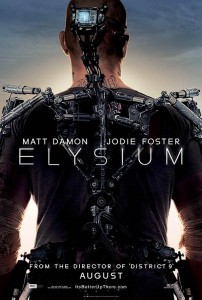 Image Engine had already been working on Elysium for about six months by the time I joined. This meant things were set up and work was progressing at a good pace. In fact, the pace was a bit of a shock at first.
Image Engine had already been working on Elysium for about six months by the time I joined. This meant things were set up and work was progressing at a good pace. In fact, the pace was a bit of a shock at first.
When I started the deadline was set for September (although that changed later). This meant we still had at least five months left for the project to run.
I was used to projects starting slowly, having most shots hang around for ages, going back and forth between departments, and stuff only really getting finalled in the last month or so of the project. I was used to target dates set this early in a project being quite flexible and vague.
So it was quite a shock to me when I realised we were expected to final two or three shots every week, even five months before the delivery date.
It had to be this way, because Image Engine were the principle VFX company for Elysium and were doing so much of the project themselves, if they didn’t consistently final shots at a steady pace from early on they would have been overwhelmed by the end of the project.
Final lighting renders would come through at the end of the previous week, then on Monday you would start your two or three shots, get versions of each one out once or twice a day, hopefully final them by Friday, and start on new shots on the following Monday.
They relied heavily on Nuke templates built by the compositing leads for each CG object, and the lighting renders were very consistent. Once the look of each vehicle, droid or environment was approved in one or two shots, we could quickly replicate that look across the rest of the sequence.
Once I got used to the pace it was a refreshing way to work. I’ve always found the longer a shot hangs around, the less enthusiastic I become about it, so starting on fresh shots every week was great. And it meant I got to final more than 30 shots myself, way more than I have ever done on any previous project.
There were review sessions with the VFX supervisor every morning, and then with the compositing supervisor every afternoon. This didn’t give you much time to hit notes in between reviews, but it did mean you got plenty of feedback. Towards the end of the project, the director would also be in the building several times a week, which meant you would get client notes within an hour of submitting a shot, rather than having to waiting a day as I was used to.
Obviously this didn’t work out perfectly every week. More complex shots, or individual shots without a predefined look, would take more revisions, or sometimes things just wouldn’t work out, but the production team were very supportive and flexible, so things could be rescheduled and work didn’t pile up. Considering the scale of the project, the amount of weekend work and overtime I did was minimal.
I think the fact Image Engine had already worked with Neill Blomkamp on District 9 also helped. I got the feeling our supervisor, Peter Muyzers, knew exactly what Neill wanted and there were rarely any big surprises from the client reviews. I think it also helped that the director has worked in VFX and knows what can and can’t be done. He also knew what he wanted, and stuck to it, so there weren’t many changes during production.
I finished work on Elysium in December 2012 – although some people at Image Engine spent a few more months on it – and the movie was released in August 2013. It was good to have such a long break between doing the work and seeing the finished movie. It meant I could watch it with fresh eyes. I think our work looked fantastic on the big screen and I was really proud of it.
If you consider the amount of great work we did, and how relatively smoothly the project ran, I think Elysium is the best project I have worked on.
EDIT: Since I wrote this post I have created a short reel of most of the shots that I did for Elysium:




Latest Comments